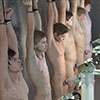Sexual recreation station 2 – Close up 4K

essay, an analytic, interpretative, or critical literary composition usually much shorter and less systematic and formal than a dissertation or thesis and usually dealing with its subject from a limited and often personal point of view.
Some early treatises—such as those of Cicero on the pleasantness of old age or on the art of “divination,” Seneca on anger or clemency, and Plutarch on the passing of oracles—presage to a certain degree the form and tone of the essay, but not until the late 16th century was the flexible and deliberately nonchalant and versatile form of the essay perfected by the French writer Michel de Montaigne. Choosing the name essai to emphasize that his compositions were attempts or endeavours, a groping toward the expression of his personal thoughts and experiences, Montaigne used the essay as a means of self-discovery. His Essais, published in their final form in 1588, are still considered among the finest of their kind. Later writers who most nearly recall the charm of Montaigne include, in England, Robert Burton, though his whimsicality is more erudite, Sir Thomas Browne, and Laurence Sterne, and in France, with more self-consciousness and pose, André Gide and Jean Cocteau.
More From Britannica
nonfictional prose: The essay
At the beginning of the 17th century, social manners, the cultivation of politeness, and the training of an accomplished gentleman became the theme of many essayists. This theme was first exploited by the Italian Baldassare Castiglione in his Il libro del cortegiano (1528; The Book of the Courtier). The influence of the essay and of genres allied to it, such as maxims, portraits, and sketches, proved second to none in molding the behavior of the cultured classes, first in Italy, then in France, and, through French influence, in most of Europe in the 17th century. Among those who pursued this theme was the 17th-century Spanish Jesuit Baltasar Gracián in his essays on the art of worldly wisdom.
Keener political awareness in the 18th century, the age of Enlightenment, made the essay an all-important vehicle for the criticism of society and religion. Because of its flexibility, its brevity, and its potential both for ambiguity and for allusions to current events and conditions, it was an ideal tool for philosophical reformers. The Federalist Papers in America and the tracts of the French Revolutionaries are among the countless examples of attempts during this period to improve the human condition through the essay.
The genre also became the favoured tool of traditionalists of the 18th and 19th centuries, such as Edmund Burke and Samuel Taylor Coleridge, who looked to the short, provocative essay as the most potent means of educating the masses. Essays such as Paul Elmer More’s long series of Shelburne Essays (published between 1904 and 1935), T.S. Eliot’s After Strange Gods (1934) and Notes Towards the Definition of Culture (1948), and others that attempted to reinterpret and redefine culture, established the genre as the most fitting to express the genteel tradition at odds with the democracy of the new world.
Whereas in several countries the essay became the chosen vehicle of literary and social criticism, in other countries the genre became semipolitical, earnestly nationalistic, and often polemical, playful, or bitter. Essayists such as Robert Louis Stevenson and Willa Cather wrote with grace on several lighter subjects, and many writers—including Virginia Woolf, Edmund Wilson, and Charles du Bos—mastered the essay as a form of literary criticism.
Special offer for students! Check out our special academic rate and excel this spring semester!
The Editors of Encyclopaedia Britannica This article was most recently revised and updated by Adam Augustyn.
Richard Howard
Table of Contents
Introduction
References & Edit History
Quick Facts & Related Topics
Quizzes
Illustration of "The Lamb" from "Songs of Innocence" by William Blake, 1879. poem; poetry
A Study of Poetry
4:043 Dickinson, Emily: A Life of Letters, This is my letter to the world/That never wrote to me; I'll tell you how the Sun Rose/A Ribbon at a time; Hope is the thing with feathers/That perches in the soul
Famous Poets and Poetic Form
Emily Dickinson (1830-1886) only confirmed photograph of Emily Dickinson. 1978 scan of a Daguerreotype. ca. 1847; in the Amherst College Archives. American poet. See Notes:
Poetry: First Lines
Related Questions
Where was Simone de Beauvoir educated?
What did Simone de Beauvoir write?
When did American literature begin?
Who are some important authors of American literature?
What are the periods of American literature?
Read Next
poem. A poet in a Heian period kimono writes Japanese poetry during the Kamo Kyokusui No En Ancient Festival at Jonan-gu shrine on April 29, 2013 in Kyoto, Japan. Festival of Kyokusui-no Utage orignated in 1,182, party Heian era (794-1192).
World Poetry Day
Close up of books. Stack of books, pile of books, literature, reading. Homepage 2010, arts and entertainment, history and society
12 Novels Considered the “Greatest Book Ever Written”
A ginger cat sleeps in his soft cozy bed on a floor carpet, soft focus
Lay, Lie, Lied, Lain: When Do We Use Which?
Chapter 4 pg 42 - Chapter header of The Adventures of Tom Sawyer by Mark Twain. Published in 1884 by The American Publishing Company
Periods of American Literature
Happy, smiling, flying pig
7 Everyday English Idioms and Where They Come From
Discover
Calendar marking march 15th
What Is the “Ides” of March?
Hindu Holi Festival celebrations with colored water, powder and colorful flower petals thrown over celebrants at a Hindu temple in Mathura, Uttar Pradesh, India on March 24, 2021.
Holi: Festival of Colors
Figure 13: A Maxim machine gun, belt-fed and water-cooled, operated by German infantrymen, World War I.
7 Deadliest Weapons in History
Black widow spider
9 of the World’s Deadliest Spiders
Obscure Freaky Smiling Psycho Man, phsychopath, sociopath, evil, mean
What’s the Difference Between a Psychopath and a Sociopath? And How Do Both Differ from Narcissists?
The Colosseum, Rome, Italy. Giant amphitheatre built in Rome under the Flavian emperors. (ancient architecture; architectural ruins)
New Seven Wonders of the World
Title: Senate Square, St. Petersburg, December 14, 1825: repression of the troop mutiny - watercolor by Carl Ivanovitch Kollman, 1825 depicts Decembrist uprising clashing with cavalry, with spectators watching. (new style December 26, 1825) Europe. Saint
8 of the Largest Empires in History
Home
Literature
Poetry
Poets A-K
Arts & Culture
Richard Howard
American author
Written and fact-checked by
Last Updated: Jan 31, 2024 • Article History
Category: Arts & Culture
Born:
October 13, 1929, Cleveland, Ohio, U.S.
Died:
March 31, 2022, New York, New York (aged 92)
Awards And Honors:
Pulitzer Prize
Notable Works:
“A Progressive Education”
“Alone with America: Essays on the Art of Poetry in the United States Since 1950”
“Lining Up”
“Misgivings”
“No Traveller”
“Paper Trail: Selected Prose, 1965–2003”
“Quantities”
“Two-Part Inventions”
“Untitled Subjects”
“Without Saying”
Richard Howard (born October 13, 1929, Cleveland, Ohio, U.S.—died March 31, 2022, New York, New York) American poet, critic, and translator who was influential in introducing modern French poetry and experimental novels to readers of English and whose own volume of verse, Untitled Subjects (1969), won the Pulitzer Prize for poetry in 1970.
Howard was educated at Columbia University, New York City (B.A., 1951; M.A., 1952), and at the Sorbonne. He then worked as a lexicographer before becoming a freelance critic and translator. He taught comparative literature at the University of Cincinnati, Ohio, and was a fellow at Yale University. In addition, Howard was poetry editor at The Paris Review (1992–2005) and at the Western Humanities Review (1989–2011).


Leave a Comment